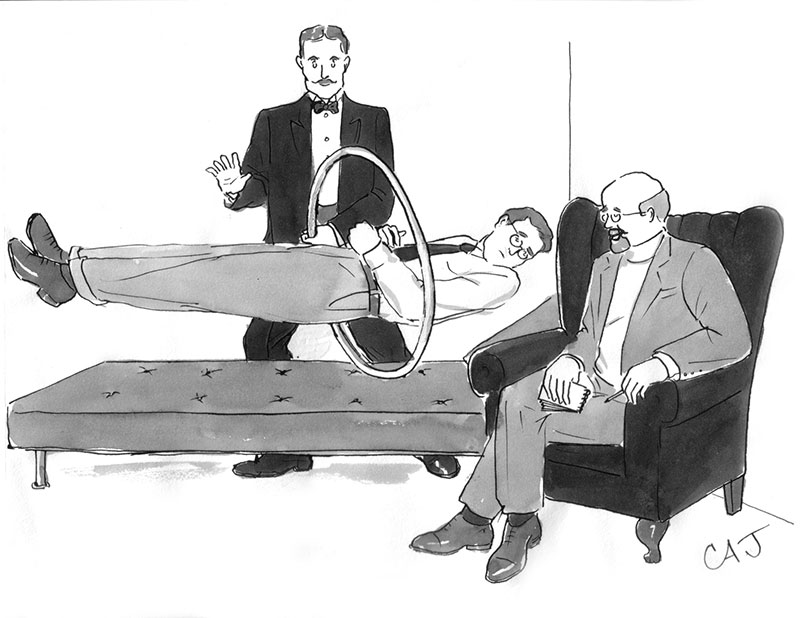 Carolita Johnson’s cartoon is set in a psychiatrist’s office, where the patient is being levitated above the couch by a magician. The magician is passing a hoop over the patient to show that there are no invisible strings. The psychiatrist is speaking.
Carolita Johnson’s cartoon is set in a psychiatrist’s office, where the patient is being levitated above the couch by a magician. The magician is passing a hoop over the patient to show that there are no invisible strings. The psychiatrist is speaking.
I first tried to reconcile the disparate elements—magic and psychiatry—by referring to a condition that causes people to believe that completely unrelated events (such as touching a light switch three times and getting a promotion) are causally connected: “This is what comes of magical thinking.”
A successful magic show depends on the performer’s ability to conceal the secrets behind his tricks, while a successful therapy session depends on the patient’s willingness to disclose everything. My next few captions highlight this distinction:
- “But can you reveal your secrets?”
- “How can I help if you won’t reveal your secrets?”
- “Just because he can’t reveal his secrets doesn’t mean you can’t talk about yours.”
In this caption, the psychiatrist is feeling competitive: “Impressive. But can he shrink your head?”
Finally, the patient passing through the hoop reminded me of a baby traveling through a birth canal, so I came up with this caption: “It’s called rebirthing therapy.”
Now let’s see how you did.
Several of you thought of the same psychiatric condition I referenced in my first caption:
- “Magical thinking seems to work for you.”
- “We call this magical thinking.”
- “That’s magical thinking.”
A couple of you had the psychiatrist describing the patient’s dilemma in both literal and figurative terms:
- “You’re going through something right now.”
- “I can see what you’re going through.”
Like I did, some of you made the psychiatrist a little competitive:
- “Yes, but can he cure your smoking habit?”
- “Impressive, but can he lift your spirits?”
These two entries cleverly turn on different definitions of the last word:
- “Do you find issue with how you were raised?”
- “Tell me about when your mother disappeared.”
As I noted above, most magicians refuse to divulge their secrets. In this entry, however, the psychiatrist is trying to understand not the mechanics of the trick but something he finds more important: “I’m not interested in how he does it. I’m interested in why?”
Here are the best references to a particular kind of regression therapy:
- “Yours must have been a difficult birth.”
- “Now, imagine the obstetrician holding you upside down.”
And here are the week’s best puns:
- “You seem detached.”
- “We all have illusions.”
I usually don’t care for captions that suggest someone misheard a word, but this entry, submitted by a person with an apparent aversion to commas, isn’t bad: “Well that’s impressive but I said I was hiring for a physician’s assistant.”
In this entry the psychiatrist’s suggesting a solution to his patient’s most immediate problem: “Have you tried firing the magician?”
The next two entries suggest that the patient fears he’s too easily controlled:
- “Why do you feel that people manipulate you?”
- “Do you sometimes feel as if people are using you?”
And in this entry, the psychiatrist is doing his best to say something encouraging:
- “At least the act is making some progress.”
- “If you can believe in magic, you can believe in yourself.”
Finally, we have a caption that assumes the patient is trying to address his magician-related phobias: “Next, we’ll work on your fear of being sawed in half.”
For the second week in a row, we had an unusually challenging contest that yielded a surprisingly small number of highlighted captions. Still, the competition for the top spot was tough. I’m going with, “At least the act is making some progress.”
ENTER THIS WEEK’S CAPTION CONTEST
Lawrence Wood has won The New Yorker’s Cartoon Caption Contest a record-setting seven times and been a finalist four other times. He has collaborated with New Yorker cartoonists Peter Kuper, Lila Ash, Felipe Galindo Gomez, and Harry Bliss (until Bliss tossed him aside, as anyone would, to collaborate with Steve Martin). Nine of his collaborations have appeared in The New Yorker, and one is included in the New Yorker Encyclopedia of Cartoons.

